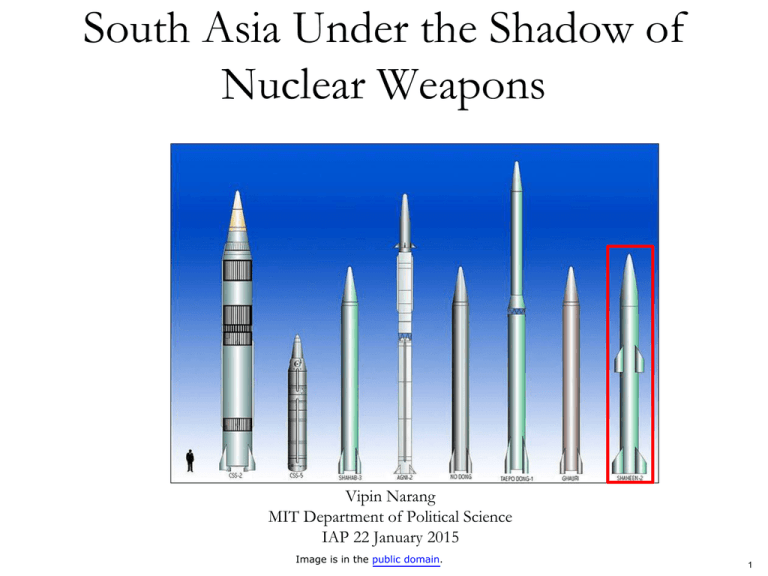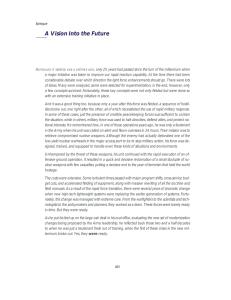
South Asia Under the Shadow of
Nuclear Weapons
Vipin Narang
MIT Department of Political Science
IAP 22 January 2015
Image is in the public domain.
1
The Puzzle
Image removed due to copyright restrictions – Please see
http://en.wikipedia.org/wiki/File:Mohammed_Ajmal_Kasab.jpg for more details.
Image removed due to copyright restrictions – Please see
http://wikiislam.net/wiki/uploads/b/b0/Images-india-0032.jpg for more details.
2
Outline
• Basics of Deterrence Theory
• Basics of Nuclear Weapons
• The Nuclearization of South Asia
• The Consequences of Nuclearization in South Asia
• How Long can this Precarious Balance of Terror Last?
3
Deterrence Theory
• Deterrence: Preservation of the status quo by
threatening unacceptable costs to an opponent if
they do X.
• Two Types of Deterrence
– Deterrence by Punishment
– Deterrence by Denial
4
Deterrence Theory
• Three requirements (aka the Three C’s):
– Capability
– Credibility
– Communication
5
Nuclear Weapons & Deterrence
• Nuclear weapons fundamentally different?
– Explosive yields
– Missile age
– Psychological impact
6
Nuclear Weapons
Courtesy of the National Nuclear Security Administration. Image is in the public domain.
7
Basics of Nuclear Weapons
• Fission weapons (5-40kT)
– U-235 (enriched uranium)
– Pu-239 (plutonium from reprocessing)
• Boosted Fission weapons (~200kT)
– Fission weapon plus Tritium/Deuterium gas (or Li-D)
• Fusion weapons (Megaton yields)
– Fission primary to ignite a fusion secondary (D-T)
8
Operationalizing Nuclear Weapons:
Nuclear Posture • How many and what type?
• How to deliver them?
– Aircraft
– Ballistic Missiles (Land based & Sea-based)
– Cruise Missiles
• How to manage them?
9
Operationalizing Nuclear Weapons:
Nuclear Posture • Deterring what?
– Deter nuclear use and coercion? Assured Retaliation
• Mostly deterrence by punishment
– Deter conventional aggression? First-use
• Can be deterrence by punishment or denial
10
The Nuclearization of South Asia
Image courtesy of Antonio Milena. License CC-BY.
11
India through 1974
• India’s Security Environment
– 1962 War
– Chinese nuclear tests
– Persistent wars with Pakistan, despite conventional
superiority
• India’s Civilian Nuclear Program
– CANDU 40 MW reactor 1954
– Reprocessing facility 1964
12
India through 1974
• Peaceful Nuclear Explosion 1974
– General security environment
– Domestic political explanation
– Power of scientific bureaucracy
• Nuclear hedging
13
Pakistan 1971-1980s
• Pakistan’s Security Environment
– Impact of 1971 War
– “We will eat grass or leaves, or even go hungry. But we will
get [a Bomb] of our own” (Bhutto 1965)
– January 1972, Bhutto authorizes nuclear weapons program
• Pakistan’s Nuclear Program
– Yes we Khan (URENCO)
– Uranium enrichment: The ‘goat shed’ at Kahuta
– U.S. role in Afghanistan
14
Pakistan Late-1980s
• Slow March to Nuclearization
– 1983 Chinese assistance (CHIC-4 design; 50kg HEU?)
– 1986: US convinced Pakistan is nuclear-capable but perhaps
not nuclear-weapons state (‘two screwdriver turns’ away)
– March 1987: Zia claims Pakistan has capability to make a
bomb
– 1988: Congressman Solarz quips Pakistan has a ‘Saturday
night special’ capability: ambiguous but effective
15
India 1974-1989
• Dormancy: 1974-1989
• Covert Weaponization: 1988-1989
– Rajiv Gandhi brings program out of dormancy
– Weapons designs, miniaturization, production
capability developed
– Delivery capabilities developed/tested
16
India 1990s
• March to Overt Weaponization
– December 1995: Rao (INC) on brink of test
– March 1996: BJP aborts test
– May 1998: BJP returns to office, tests 5 fission
devices at Pokhran
• Several plausible explanations (security, domestic politics,
status)
17
India 1998-present
• India’s Nuclear Posture: Assured Retaliation
– Civilian custody of nuclear weapons
• DAE
• DRDO
• SFC
– Deterring nuclear use against Indian cities: Deterrence by
Punishment
– No First Use
18
Pakistan 1998-present
• Steady expansion
– Uranium Enrichment
– Plutonium production and reprocessing goes online
– Delivery capabilities bought from China and North
Korea (M-11, M-18, No-Dong)
• Overt Nuclearization
– Indian tests left Pakistan with no option in May 1998
19
Pakistan 1998-present
• Pakistan’s Nuclear Posture: First Use
– Military custody of nuclear weapons
– Asymmetric escalation of conflict to deter Indian
conventional power: Deterrence by Denial
– Development of ‘battlefield’ nuclear weapons: NASR, Ra’ad,
Babur
20
Consequences of Nuclearization: Phase I
(Covert Nuclear Period 1986-1998)
• Conventional Wisdom: MAD is stabilizing
– Hefty Assumptions
• South Asia different from Cold War
• Effect on Crisis Outbreak
– Pakistan slightly emboldened to support proxy forces
– India undeterred and has preventive war incentives
• Two Militarized Crises in this period
– Brasstacks 1986-1987
– Kashmir Compound Crisis 1990
21
Consequences of Nuclearization: Phase II
(Overt Nuclear Period 1998-2009)
• Effect on Crisis Outbreak
– Pakistan more aggressively emboldened
• Revisionist intentions able to pursued with higher
frequency and intensity at both conventional and subconventional levels
– India significantly deterred from conventional
retaliation
22
Kargil 1999
Courtesy of the US Navy. Image is in the public domain.
23
Kargil 1999
• India deterred from retaliating?
– Expected BJP response: aggressive
– Actual BJP response: muted
• Constrained IAF and Army from crossing LoC and IB
• Costly curtailing of military options for fear of triggering
Pakistani nuclear use
24
Operation Parakram 2001-2002
Dec 13, 2001:
Pakistani-backed
Parliament attack
January 2002:
BJP contemplates
limited war
May 14, 2002:
Pakistani-backed
Kaluchak massacre
June 2002:
BJP prepares for largescale conventional war
June 2002:
Pakistan explicitly
threatens nuclear use
October 2002: BJP demobilizes
Based on: VK Sood and
Pravin Sawhney, Operation
Parakram:The War Unfinished,
2003.
© Map Library. Some rights reserved. CC BY-SA. This content is excluded from our Creative
Commons license. For more information, see http://ocw.mit.edu/help/faq-fair-use/.
25
Operation Parakram 2001-2002
• Most likely case for an aggressive BJP response
• BJP balks in June 2002. Why?
• Power of Pakistan’s first use posture
26
Mumbai 2008
• Lashkar attacks on Mumbai, 26 November 2008
• Congress refrains from conventional retaliation
• Former CoAS: Pakistan’s posture deterred Indian retaliation
• “But when the dust settled, all [the principals] agreed that the
unpredictability on the Pakistan side and the fear that its decision
makers could opt for a disproportionate response, including the nuclear
option, stymied any possible chance of military action on India’s
behalf after 26/11.”—Indian Express, 26 November 2010
27
Summary for Phase II
• Effect on Crisis Outbreak
– More frequent and intense crises triggered by
Pakistan
– Emboldened by shield of first use nuclear posture
• Effect on Crisis Stability
– Crises capped now because Indian full-scale
conventional retaliatory options are off the table
28
How Long Can this Last?
• Indian frustration: Traded conventional superiority for
Pakistani subconventional aggression
– Revisions at conventional level: “Cold Start”?
– Consequences of this shift?
• What effect will Cold Start have on Pakistan’s conventional and
nuclear postures?
• Indian response to deter battlefield nuclear weapons
• Pakistani use of ‘proxy forces’ as strategic policy
• Dangerous arms race + Fuse for crises under quasisovereign control (e.g. LeT) = A region on the brink
29
MIT OpenCourseWare
http://ocw.mit.edu
RES.8-004 Reducing the Danger of Nuclear Weapons and Proliferation
January IAP 2015
For information about citing these materials or our Terms of Use, visit: http://ocw.mit.edu/terms.






